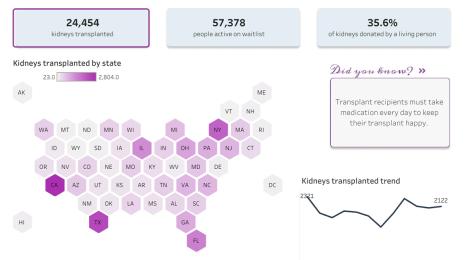Enabling schools to manage COVID-19 using data-driven analysis
This blog takes a look at two stakeholder groups: students and their families, and teachers and administrators. In each case, we'll see examples of how people are using data to overcome barriers imposed by the pandemic.

Hard as it is to grapple with the many far-reaching impacts of COVID-19 on our culture, it's even harder to imagine how we would have coped with the same situation even a few decades ago. If the pandemic had hit in 2000 instead of 2020, where would we be? The virtual meetings we conduct for our daily work wouldn't be live on video with document sharing; at best, we'd be on conference calls and sending artifacts by fax. Our safety updates about the virus wouldn't arrive via social media; we'd mostly rely on word of mouth, the daily papers, and the evening news.
Likewise, schools would have been in even graver danger of being left behind by COVID-19 than they are right now. The virus has made traditional day-to-day K-12 education all but impossible for the moment, and schools are working with the latest technology to serve their needs in the best ways possible.
So what does that look like? How are schools meeting the need for solutions that address the breadth AND depth of the problem? How are they coordinating resources across disconnected, socioeconomically diverse student populations, and meeting the needs of all involved? This blog takes a look at two stakeholder groups: students and their families, and teachers and administrators. In each case, we'll see examples of how people are using data to overcome barriers imposed by the pandemic.
Gathering data from students and families
For most school districts, the first step in providing an alternate system of instruction was to assess what students wanted and needed in order to participate. They distributed surveys to households, both on paper and over the phone and web, to find out each student's readiness for online remote learning. Did they have a laptop or other connected device for attending classes? Did they need a Wi-fi hotspot in order to access the internet? Once online, could they successfully connect to the district's learning systems?
In addition to technological readiness, surveys were also useful for tracking students' engagement. "We wanted to know how students were feeling about distance learning," said Hope Langston, director of assessment services for the Northfield Public School District in Minnesota. Survey responses indicated the level of difficulty students have adjusting to the changes, helping identify areas that needed the most urgent attention. Northfield continues to offer follow-up surveys that help measure their progress in addressing these issues over time.
Equal Opportunity Schools (EOS), a Seattle-based nonprofit dedicated to improving access for students of color and low-income students, has conducted research throughout the pandemic that assesses remote learning by aggregating various factors of student sentiment, including teacher and principal evaluation, barriers to motivation, and "belonging" as it pertains to their identity, culture, and classroom experience. EOS uses Tableau to relate these factors to one another and gain insights into possible paths for achieving a more comprehensive learning experience for all students.

Equal Opportunity Schools student experience dashboard (EOS)
But school isn't entirely about teaching and learning. Districts have resources that help make sure students are healthy and safe, and deploying those resources during COVID-19 also requires a data-driven strategy. The El Paso Independent School District input survey data into Tableau visualizations and used them for planning nutritional and medical interventions where they were needed, including conducting telehealth sessions between school nurses and students who fell ill. If a household couldn't be reached for survey or classroom participation, truancy officers investigated to check on the wellbeing of students in their homes. As a district whose majority population is economically disadvantaged, and where one-third of students has limited English proficiency, these interventions were especially important for ensuring effective, equitable outreach.

Student response dashboard (El Paso Independent School District)
Similarly, Northfield used Tableau to visualize survey responses and other data related to their holistic pandemic response, with a heightened focus on achieving equity for underserved areas of the district's community, one-quarter of whom qualify for free and reduced lunch. Using a need-based "heat map" visualization as a daily tracker, Northfield set up food distribution centers in strategic locations and tracked the number of meals delivered per day at each site. Langston and her team also used the data to mobilize local volunteers to help families with language and socioeconomic challenges navigate connectivity.

Meal distribution counts by location (Northfield Healthy Community Initiative)
Throughout these efforts, the availability and visibility of survey responses and other data has been key to coordinating an effective response. "Our dashboards help us meet a need in our community, by getting us the information we need as clearly and as quickly as possible," said Langston. "We couldn't have done this if we didn't have an accurate picture of what the need is."
Empowering teachers and administrators
Teacher readiness—both practical and emotional—is another important factor in achieving effective remote learning operations, and many districts are using a similar survey-based approach to stay connected with educator sentiment. School administrators rely on this information to make sure teachers are getting the resources and support they need, as well as to work with teachers on tracking student engagement and taking action where needed to help their situation improve. In El Paso, Tableau dashboards track data from the district's remote learning platform and student information system to identify gaps in learning and take immediate action to address them. Viewing data at the district and school levels, and then filtering it down to specific populations or individual students, make it easy to quickly identify students at risk and report each case to the relevant principal or teacher. The visualizations are used to lead weekly meetings among school principals and assign school-specific tasks.

El Paso Schoolology participation rates (El Paso Independent School District)
El Paso also used analytics and reporting to track compliance with new participation-based grading systems, which most teachers had never used before COVID-19. When teachers weren't trained or reminded to use the new system, the grades they reported in the remote learning platform didn't match the new guidelines, potentially confounding the ability to measure student progress. By visualizing the data and seeing the discrepancies, administrators could contact and coach the affected teachers and help bring the invalid grades to a point of fidelity with other measurements in the system.
Preparing for the immediate and long-term future
As schools continue to evolve their policies and practices, both during and after COVID-19, data will play a key role. Districts that lead the way with data-focused innovations are already finding success in adopting new policies that their states set forth. El Paso's approach to remote learning helped it comply with new standards for student engagement imposed by the Texas Education Authority (TEA) and could readily report its progress to TEA using the codes visible in Tableau. The better equipped a district is to tackle problems efficiently and at a granular level, the more capably they can face down unknown challenges in the future. To see example visualizations from El Paso ISD and other K-12 institutions using Tableau, visit the Tableau Use Cases in Education site.







